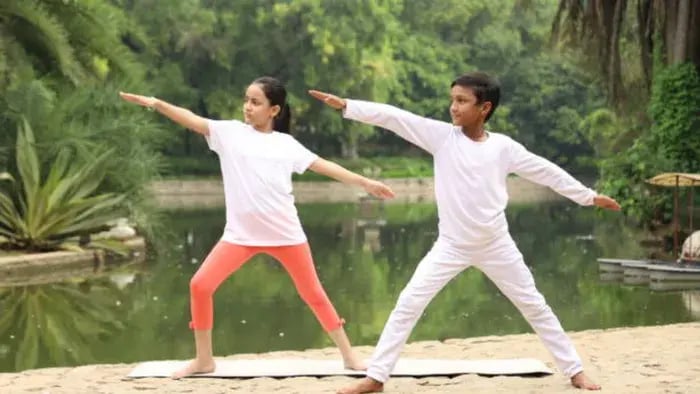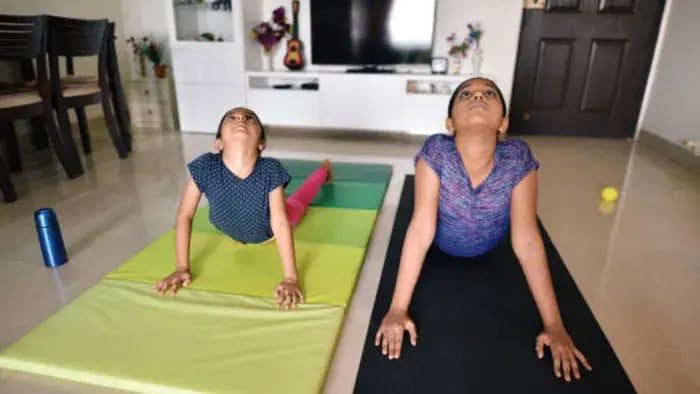- Create a Safe and Quiet Space
- Make It a Regular Practice
- Start Small
- Nourish With Good Food
- Use Kind Words Not Corrections
- Do It With Your Child When You Can
- Support Rest and Recovery
Introduction

Every kid faces growing pains, not just physical, but emotional as well. Whether it’s learning new skills, managing big emotions, or just adjusting to changes in their body, kids carry tension without even realising it. According to a study published in Eur J Psychotraumatol. 2021, somatic exercises are a gentle and effective way to help them become more aware of their body and movement. These slow, mindful exercises guide kids to notice how their muscles feel, move with intention, and release tension that may be stored deep within their bodies.
Unlike regular workouts, somatic movements focus on internal awareness rather than external performance. The goal is not to stretch further or move faster but to feel better. Through repeated gentle movement and deep breathing, kids can improve their posture, increase flexibility, and feel more grounded. This helps them stay calm, focused, and better able to handle everyday emotions and physical discomfort.
For parents, somatic exercises are a tool to support your child’s development and emotional regulation. They’re easy to follow, require no equipment, and can be done together as a calming family routine.
What are Somatic Exercises?
Study published in Phys Med Rehabil Clin N Am. 2020, Somatic exercises are slow, gentle, and mindful movements that help you become more aware of how your body feels and moves. The word “somatic” comes from the Greek word soma, meaning “the body as experienced from within”. These exercises release physical tension by retraining the brain-muscle connection.
Instead of forcing a stretch or repeating fast movements, somatic exercises encourage listening to the body, moving with intention, and paying attention to sensations. Over time, this can improve posture, flexibility, and relaxation. For children, somatic exercises can be particularly beneficial in managing stress, calming the nervous system, and supporting both physical and emotional development safely and naturally.
A Parent’s Guide With 7 Essentials for Supporting Somatic Exercises in Children

Create a Safe and Quiet Space
Somatic exercises require stillness and focus, so it’s essential to provide your child with a quiet space at home. Choose a quiet corner with a soft mat, gentle lighting, and minimal noise. This isn’t about perfection, it’s about making your child feel at ease and unobserved. If your child feels too exposed, their body may stay tense; giving them their favorite toy or blanket can help them settle into the space with comfort and trust.
Make It a Regular Practice
Set a regular time for somatic movement, such as before bed or after school; even 10-15 minutes can make a significant difference. When it becomes part of your child’s routine, they start looking forward to it. This consistency also builds emotional safety, helping your child feel more in control of their thoughts and feelings.
Start Small
Simple exercises, such as slow head turns, shoulder rolls, or belly breathing while lying down, are a great place to start. The goal is to help your child feel their muscles move, not to stretch as far as possible. Ask them to move like they’re floating underwater or waking up from sleep—this kind of language makes it feel playful and safe.
Nourish With Good Food
Foods rich in Omega-3s, like flaxseeds, walnuts, and mustard oil, help reduce inflammation and calm the nervous system. For children who are lactose intolerant, consider using dairy-free options such as almond milk in smoothies or coconut curd in meals. Avoid heavy, processed foods before sessions and opt for light snacks, such as banana slices with peanut butter or homemade laddoos with flaxseeds, for a steady energy boost.
Use Kind Words Not Corrections
When guiding somatic exercises, avoid saying “Do it right” or “That’s not how it’s done”. Instead, use encouraging phrases like “What does your shoulder feel like?” or “Try moving a little slower this time”. This allows your child to explore without pressure. Somatic work is not about perfect form; it's about feeling and connection. Your words help shape their inner confidence and trust in their own body.
Do It With Your Child When You Can
Children mirror what they see. When you do exercises with your child, you demonstrate that body awareness is for everyone, not just children. Doing these exercises side by side, even in silence, builds connection. It also gives your child the confidence to try new things without fear of judgment. Make it playful—move like trees swaying in the wind or lions waking from a nap.
Support Rest and Recovery
Somatic exercises should end with a few minutes of quiet rest. Ask your child to lie down, close their eyes, and take deep breaths. You can play soft music, use a lavender eye pillow, or gently rub their hands to help them relax. This final pause allows their nervous system to absorb the practice. Over time, they will learn that rest is just as important as movement.
Conclusion

By creating the right setting and habits around somatic movement, you’re not just helping your child stretch or relax; you’re teaching them to listen to their body, respect its signals, and feel safe within themselves. These moments become more than exercise; they become acts of self-care that stay with your child as they grow.
Her love for storytelling began with reading her grandfather’s speeches, where Tarishi saw the power of words in creating lasting memories. Combining her passions for food and writing, she has turned her life into a fulfilling path of sharing stories that celebrate flavours and how food brings communities together.
The views expressed are that of the expert alone.
The information provided in this content is for informational purposes only and should not be considered a substitute for professional medical advice, diagnosis, or treatment. Always seek the advice of your physician or another qualified healthcare provider before making any significant changes to your diet, exercise, or medication routines.
















